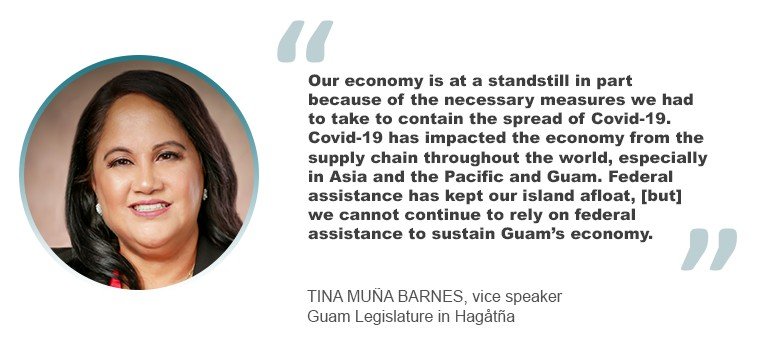Guam, a U.S. territory in the western Pacific Ocean located roughly midway between Papua New Guinea and Japan, hopes to reinvent itself as a transhipment hub in order to boost an economy reeling from the Covid-19 pandemic.
A task force met on June 24, 2021, to consider what steps the island should take; the task force was created by Public Law 36-23, which was signed into law by the island’s governor on May 12, 2021.
Prior to Covid-19, Guam’s economy operated with three main sectors: tourism, primarily from Japan and South Korea; spending by both the local and U.S. federal governments; and spending by the U.S. military, which maintains both Navy and Air Force bases on the island. “However, now our economy is at a standstill in part because of the necessary measures we had to take to contain the spread of Covid-19,” said Vice Speaker Tina Muña Barnes, who introduced the bill which became Public Law 36-23, at the task force meeting. “Covid-19 has impacted the economy from the supply chain throughout the world, especially in Asia and the Pacific and Guam. Federal assistance has kept our island afloat, [but] we cannot continue to rely on federal assistance to sustain Guam’s economy.”

In addition to supplies arriving on the island via military transport, the Port Authority of Guam’s commercial port saw throughput of 190,200 TEUs through year-end December 2019, up from 181,800 TEUs at year-end December 2018. The port also handles breakbulk shipments. Of a total 1.12 million total revenue tons handled in Fiscal Year 2020, transhipment accounted for 311,425 total revenue tons.
Shipping lines using Guam include Matson, APL, and Kyowa Shipping. Matson and APL connect Guam to the U.S. West Coast; all three provide service to other islands in Micronesia, including neighbouring Saipan, as well as islands in Palau, the Federated States of Micronesia and the Marshall Islands.
The A.B. Won Pat International Airport was, pre-Covid, host to several airlines, and played a role as a hub for United Airlines and for all-cargo scheduled and charter Asia Pacific Airlines.
Muña Barnes said at the task force meeting that the island needs a permanent revenue source; she believes transhipment is the answer the island seeks, stating that it will help diversify the economy and assist in the recovery of the island’s economy by increasing the production and sale of goods from Guam, creating thousands of jobs in the process.
Guam is well-placed both geographically and politically to take on such a role, backers believe. Members of the Guam Legislature, in passing the bill, said the island could serve as a secure port for goods to flow from manufacturing hubs in the Indo-Pacific region and into the United States, the Pacific Daily News reported after the bill was passed.
“Our island is unique because we can receive more shipments in comparison to other ports in the Pacific. The commercial port has convenient access to the Antonio B. Won Pat International Airport, allowing major airlines to fly to cities in the mainland from Guam, and the Port Authority has the ability to move and containerize and bring home fresh fish cargo. Not only does Guam have easy access to manufacturing in the Asian Pacific supply chain, but also our strategic location allows the United States to secure the defense of the nation and protect its allies. We must do what we can to rebuild our economy,” said Muña Barnes.
In April 2021, when the legislature was first hearing the bill, Port Authority of Guam General Manager, Rory J. Respicio testified in its favour, stating that “this bill could not have come at a better time for us as leaders of this Island to set the foundation needed to implement the initiatives that would diversify our island’s economy and expand job opportunities for our people.”
Also at that time, former Governor Carl T.C. Gutierrez submitted testimony in support of an “intriguing and forward-looking transshipment industry-development legislation.” He adds that “The aim of your Transhipment Task Force would help the Leon Guerrero-Tenorio administration accomplish these diversification goals by establishing Guam as a manufacturing and transhipment hub. Congruently, [the bill] encourages the U.S. to make better use of the Jose D. Leon Guerrero Commercial Port and A.B. Won Pat International Airport to help protect the Maritime Transportation System (MTS) from vulnerabilities exposed during the worst throes of the Covid-19 pandemic. And this makes perfect sense. Guam’s only commercial seaport is a designated U.S. Strategic Port. Our only commercial airport operates the closest U.S. aviation terminal to Southeast Asia.”
Gregory Glass


-x-large.jpg)
